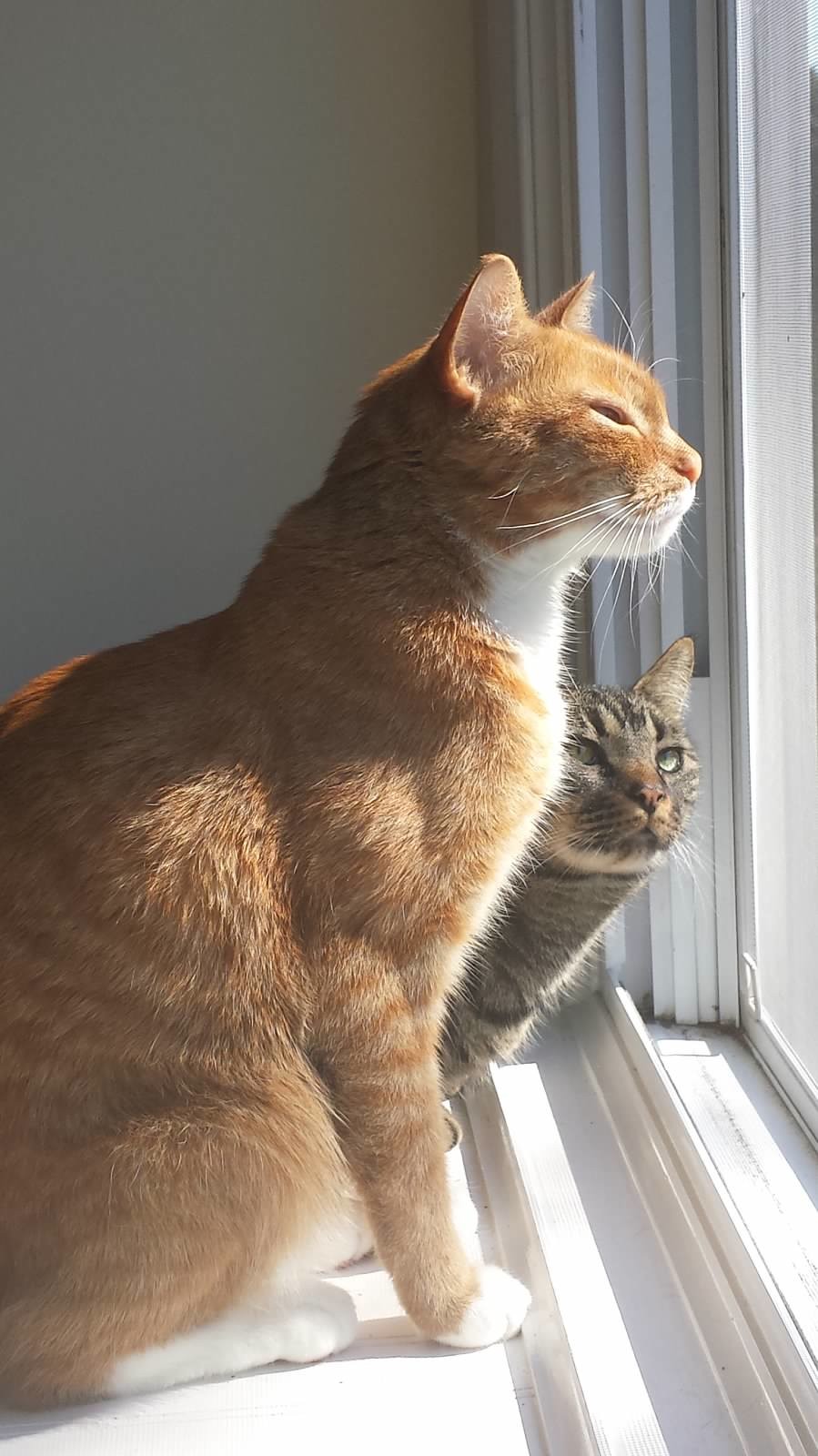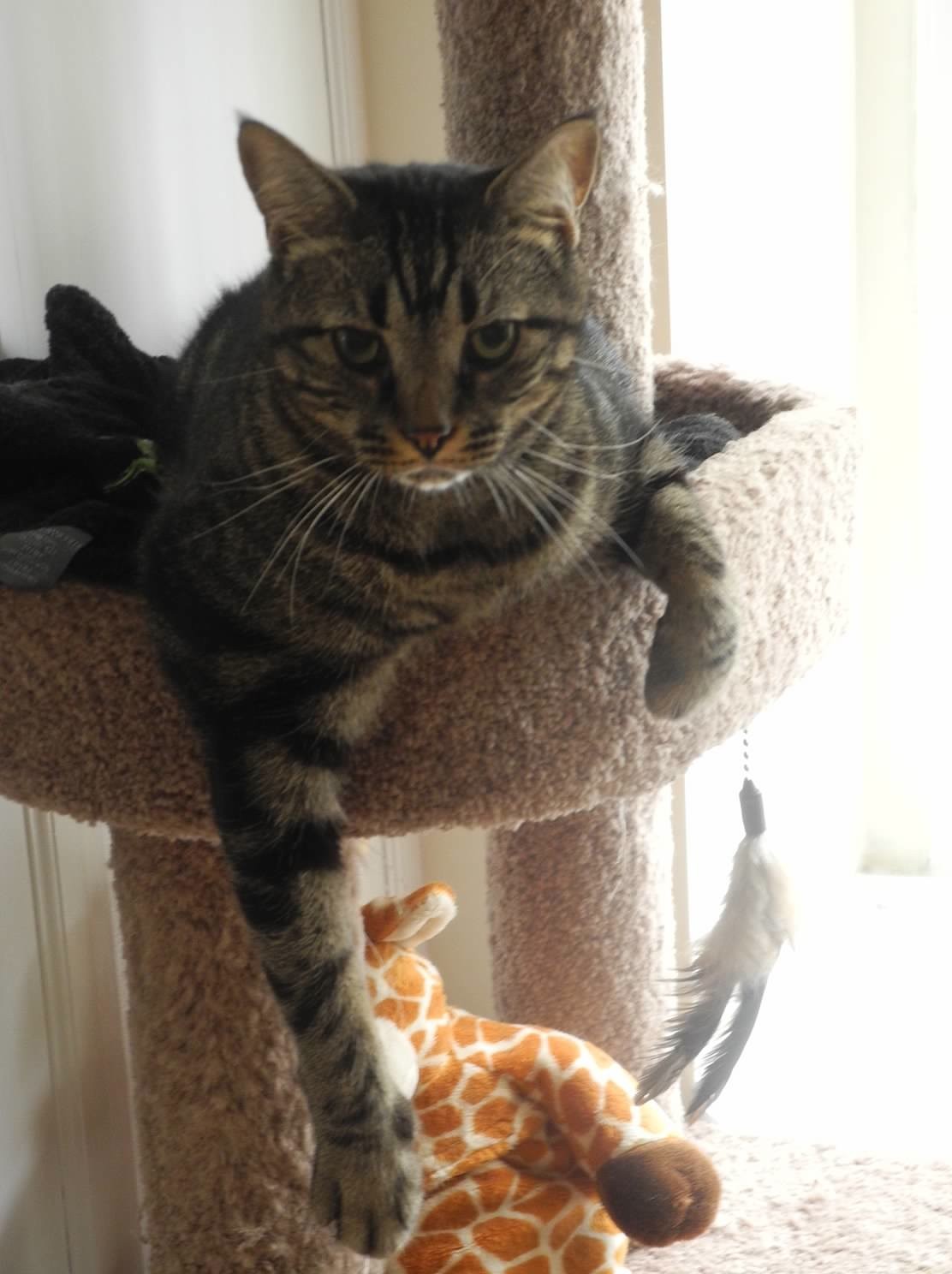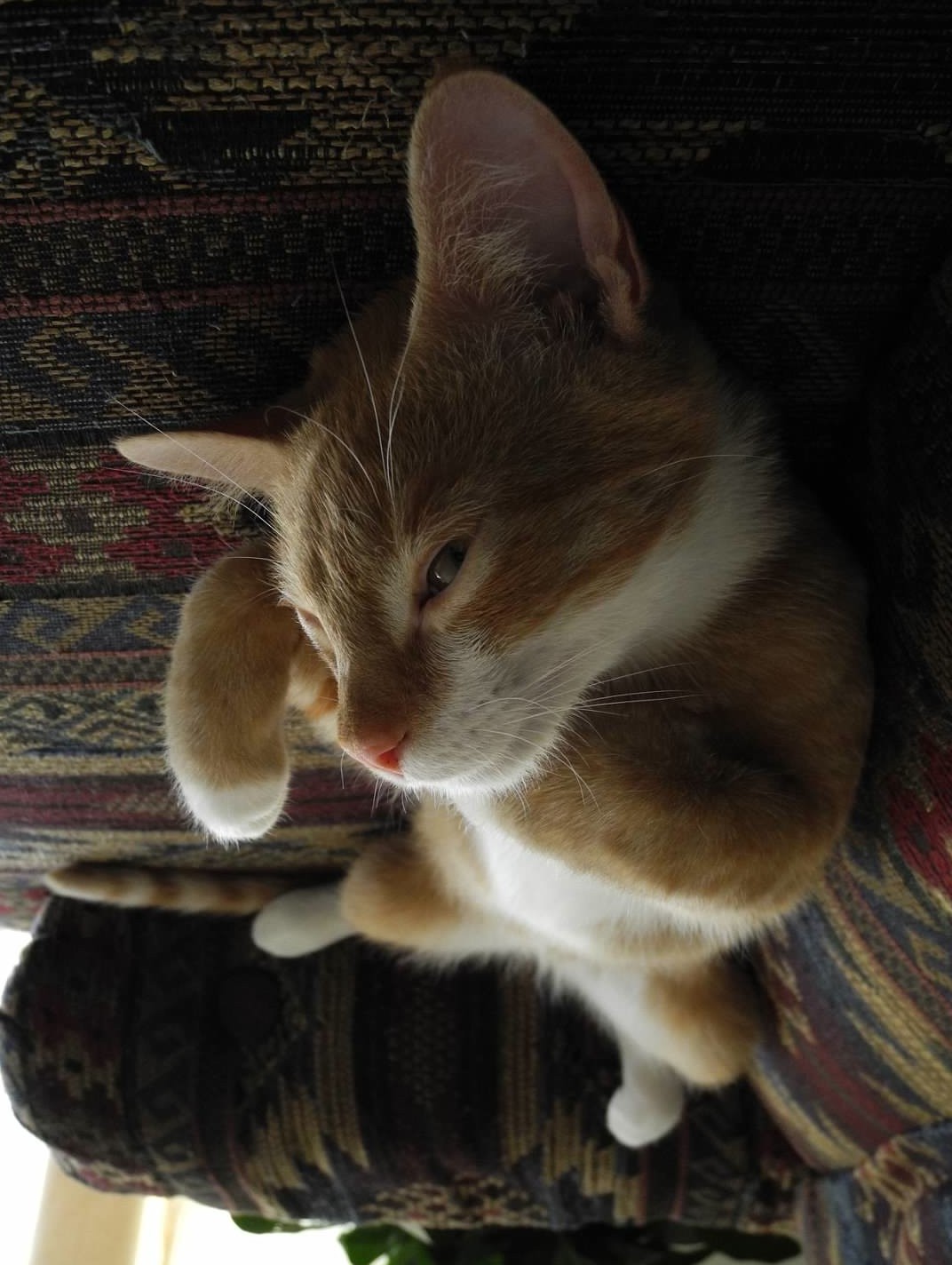Dog v Cat Intelligence – Perspective
Neuron counts don’t actually count
original article by S. Veigel June 9, 2020
Cat photos by Svetlana Veigel – Dog photos by Steve Veigel
 I’ve lived with multiple cats and multiple dogs (occasionally at the same time) throughout my life. So I don’t have a bias favoring one over the other. I’ve had cats follow me to, sit with me and follow me home from a park in the evening just like a dog. So this article – required to be science based for the most part – is probably not going to end like it began. Regardless of which side of the Cat verses Dog intelligence argument you’re on, bear with me. Consider the following in its entirety. I’m not going to just echo every other web post.
I’ve lived with multiple cats and multiple dogs (occasionally at the same time) throughout my life. So I don’t have a bias favoring one over the other. I’ve had cats follow me to, sit with me and follow me home from a park in the evening just like a dog. So this article – required to be science based for the most part – is probably not going to end like it began. Regardless of which side of the Cat verses Dog intelligence argument you’re on, bear with me. Consider the following in its entirety. I’m not going to just echo every other web post.
I recently had to take down my original post about dog and cat intelligence because there was new scientific evidence. Though disappointed, facts are facts.
My original post on cat verses dog intelligence had some content quoting a study from a Live Science website article titled “Are Cats Smarter Than Dogs” (May 20, 2014). In that article the facts were that a cat’s brain only accounts for 0.9% of their body mass and a dog’s brain accounts for 1.2%. But even though the dog brain has a higher percentage of total body mass it was found (at that time – according to the article) that the cat had 300 million neurons in the cerebral cortex – the brain region responsible for information processing – compared to the dog’s neuron count of 160 million. Science, right?
On Dec 1, 2017 Sci-News (and many others) reported “the first study to count the number of cortical neurons” where dog’s had 530 million cortical neurons and cats had 250 million cortical neurons. And this appears to be where we’ve landed in 2020 with most articles quoting the 530-250 million neuron count. Did we just get better at neuron counts in 3 years? I guess so. So that means dogs are smarter now?
Suzana Herculano-Houzel is a Brazilian neuroscientist who moved to work at Vanderbilt University in 2016. With quite an impressive number of degrees and experience she knows about neuron counts. On her website http://www.suzanaherculanohouzel.com/ there are many articles and videos well worth your time. In the first video she gives a talk at TEDxNashville titled, “Why do we have to go to school, really?” In this talk she covers an easy to understand tapestry of subjects about neuron counts, how they require energy, what makes us different and how the count doesn’t mean much if they aren’t connected. The quote from Sir Ken Robinson at the top of her page sets the stage. In part it reads, “…16 billion neurons give us human capabilities, but not abilities”.
With that invitation to view Suzana Herculano-Houzel’s website, allow me to Segue (seg-wey) back to the discussion here.
The argument between cat and dog intelligence has been an obsessive competition going on since I was a kid (I was 68 in the year 2020). Most evidence – before neuron counts – I heard about was based on studies like the “Maze Experiment”. Take a dog and put a treat or some food at the end of a maze and watch how the dog solves the problem of getting to the food. Dog finds food. Dog smart. Set a cat at the beginning of the maze and the cat just sits there. Even a hungry cat. So cat can’t solve the maze. Cat not smart. It was a valid experiment for observing behavior but it doesn’t have anything to do with intelligence. It just means that most dog owners conducting or quoting the maze experiment don’t understand the difference. The word “Independent” in the case of the cat also doesn’t explain it. The word “independent” itself is mired in a lot of misconceptions and bias. It really begs for a better argument in defense of both.
Consider this comparison:
 I: The Dog and the maze experiment
I: The Dog and the maze experiment
Since the very beginning the dog (a descendant of the gray wolf) was a pack hunter. To find prey they tracked it with their nose. Yes they can see and they have great hearing but their primary tool is first their nose. They can smell a hundred times better than we can. And in a field covered with rabbit tracks they can discern which trail is the freshest. When they find their prey they only have one tool at their disposal. Their mouth (their claws are worthless for catching and killing). If they can bite it and kill it, they eat. If it’s big they don’t. Unless they have a pack to corner and disable a vulnerable large animal and then kill it via a considerable group effort.
To be an effective pack member in a successful pack each dog has to learn to work with and respect the hierarchy. For there to be packs the dog has to be equipped with a strong desire to please and get along (most wolves in a pack are family members). Hence the inborn desire to please and get along with humans who also control their food and sense of security. This inborn nature that motivates them to pay attention combined with a great need to please also makes them “Trainable”.
It’s been said that a dog can smell their owner from miles away. Put a dog at the beginning of the maze and they’re going to track the smell through the maze based on where the strongest scent is coming from. They can also smell anything that has touched or previously went through the maze.
 II: The Cat and the maze experiment
II: The Cat and the maze experiment
If you don’t know cats the word “Independent” is not going to help you. The cat does not hunt with the nose. Though it can be very affectionate and enjoys company it is self-sufficient without the need to hunt with a pack.
Unlike the dog, the cat is armed with sensitive whiskers to detect the space and motion around it (even small changes in the air). The cat has acute hearing and eyes that help it see in the dark. It’s equipped with patience and the ability to intently watch and discern what’s going on in the surrounding environment. They are quiet and very stealthy with hooked claws and lightning quick movements. They can climb a tree, jump 6 feet from a crouched position and 1 out of every 5 pounces will result in a kill. If a mouse runs in a hole the cat will reach in, hook it with a claw and pull it out. If it can’t reach the mouse, it may lay there patiently watching and listening until the mouse feels safe enough to poke its head out.
Place a cat at the beginning of a maze where it can’t see the food at the other end, the cat is not going to sniff it out. Not because it’s “Independent” or that the cat doesn’t care, it just doesn’t hunt that way. It will go after what it sees and/hears. So it’s not going to go into a maze unless it just wants to look around a bit or take a nap inside. But if you could get a mouse to run into the maze and let the cat see it one of two things is most likely going to happen. Either the mouse won’t get far, or the cat will wait for it to poke its head out.
After thought: Cats like bags and boxes to play and sleep in but they are suspicious and/or cautious of structures you want to stick them in; or might contain some unknown threat. Is that the same maze the dog went through? They can smell a dog.
So basically, I would suggest, the “Maze Experiment” doesn’t measure intelligence. It simply provides one way to observe behavior. The way each animal behaves depends on its focus. So why are we still arguing the maze experiment?!
III: “…neurons give us… capabilities, but not abilities”
Referring back now to the infamous neuron counts, Suzana Herculano-Houzel points out that the number of neurons are meaningless without the ability to make connections between some of the neurons (she explains this in a far more brilliant way than I can of course). In chimpanzees there are plenty of neurons. But neurons require energy. Chimps don’t build houses or ponder the universe because they need to “focus” on eating most of the day. When humans started preparing foods we were able to eat less often because we were then able to release more energy in each meal. Instead of spending most of the day eating we could then start making more neuron connections for other purposes, explore the world and build.
Last of all consider these two examples and tell me which one is more “intelligent”:
There was a very popular You Tube video awhile back where a Beagle was caught on a home security camera getting some chicken nuggets out of a toaster oven. The most amazing thing to see wasn’t the dog opening the oven; that’s easy. It was that the dog went to the kitchen table and pushed a chair over to the counter so it could get up on the counter and then over to the oven. That’s problem solving!
On the other hand, I had a cat named Precious who never got on You Tube. It didn’t exist back then. In the late 1990’s there was a large cat food bag you could buy that actually had a zipper closure on it. Not a Ziploc seal, a zipper. We’d sometimes lay the bag on top of the clothes washer when we were done. Since the laundry room was next to the kitchen I was able to sit and have coffee watching something amazing. Precious had jumped up on top of the washer and was trying to figure out how to get into the cat food bag. She could have ripped the paper open, but after seeing us open the zipper to dole out her food she quickly focused on the task.
I don’t know how long I watched Precious trying to work the zipper but I was absolutely spell bound for quite a while. First she’d study the zipper and change position over it a few times. You could see her laser focused, not on the bag, but on the zipper tab itself. She pawed it and then decided the hole in the zipper tab had to be the key. Sticking her claw into the tiny zipper tab hole she tugged. When that didn’t work she changed body position over and over, still using her claw in the zipper tab to tug from different positions. The only thing that kept her from opening the bag was that the end would pull up when she tugged on the zipper so she couldn’t apply enough force to move it. If she had the body capable of holding the end down while tugging the zipper tab she would have unzipped the bag. That’s genius!

IV: Define intelligence
Personally, though we can measure, observe behavior, watch a brain light up under different stimuli, count neurons and test human students on subject matter the idea of measuring “intelligence” itself still alludes us. How a student performs, for example, has a great deal to do with focus (interest/personal need), opportunity, the teacher, environment and even hunger. For animals and humans it has everything to do with neuron connections, not the number of neurons. A cat or a dog does not need 16 billion neurons. I don’t think we know how many neuron connections are needed to just remember a life time of scent information. Or how many connections are required to indicate more or less intelligence. We can see activity but we can’t see intelligence.
The zipper? You probably couldn’t devise an experiment to get a cat to do that. You had to be fortunate enough to observe it when the cat thought of it. And that animal behavior, I suggest, wasn’t just basic animal problem solving. That animal behavior included quick observation, devising a plan, and intent teetering on the edge of experimentation and analysis. I saw it. I paid attention.
No doubt the argument will continue. But neuron count alone doesn’t really count as a conclusion. Does it? With all the ways we’re learning about how animals use tools, communicate and solve problems maybe we’re the ones who are missing the point.